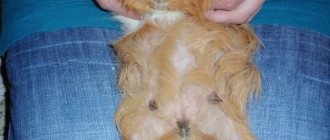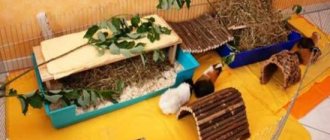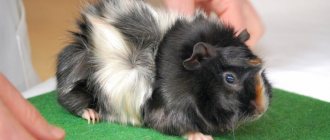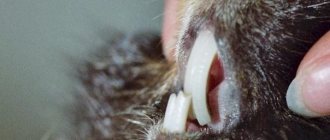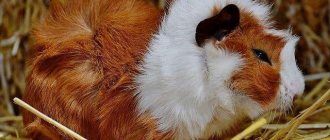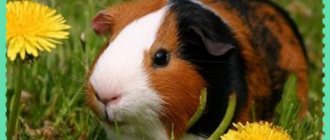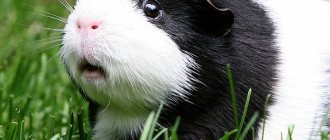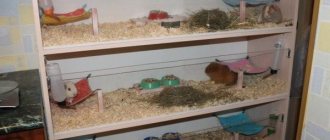Coronet is a guinea pig obtained through careful selection and crossing. Several decades ago, an Englishwoman named Claire White, who breeds guinea pigs, decided to breed a new breed of these animals. As parents, she chose representatives of short-haired and long-haired breeds - English Crested and Sheltie, respectively. As you know, the “highlight” of Crested rodents is the hair on the head, growing in a rosette. As a result of the selection, a breed of long-haired pigs with a woolen crown on their heads was born, which received the characteristic name Coronet.
Description
Coronet pigs are very beautiful. The main characteristic feature of the appearance of this long-haired animal is that the hair on the pig’s head is naturally arranged in a kind of rosette crown. The body's fur is thick. Forming a parting on the back, long hairs fall from the sides of the animal and create a kind of train. Coronet wool is characterized by:
- softness;
- smoothness;
- silkiness.
A woolen crown is placed on top of the head. The less visible the center of the rosette, the more elite the animal is considered. For the crown, symmetry and integrity are important - the structure should not fall apart. The best shape for a rosette is considered to be something like a deep bowl.
In terms of possible color options, these rodents are distinguished by their diversity. You can meet animals of this breed:
- plain;
- two-color;
- tricolor;
- spotted.
The physique of adult animals is dense and proportional, at least 20 cm long. From above, the body of the fluffy animal is shaped like a pear or a teardrop. Adult animals weigh 0.8-1 kg, but there are also record holders weighing more than 1 kg (their body length exceeds 30 cm).
The head is large, and the effectiveness of the rosette crown depends on its dimensions (the wider and larger, the better). The nose is short, the eyes are bulging. The ears are quite large in size, with the tips down and pointed forward.
Long-haired guinea pigs
There are many varieties of long-haired guinea pigs. The length of their fur can reach 20 cm. Rodents differ from each other in the structure of their coat: some have straight hair, others have wavy or curly hair. Fluffy guinea pigs come in a wide variety of colors.
Coronet
This breed of guinea pig is relatively young. It was registered in 1998 in the USA. Its creator is Englishwoman Claire White. In the late 70s of the last century, she decided to cross two breeds of pigs:
- Sheltie - owners of long and smooth hair;
- Cresteds, which have a beautiful rosette on their heads.
As a result of the breeder's painstaking work, a new variety appeared. Its representatives inherited from their ancestors long, smooth hair and an original cowlick on their heads.
These are proportionally built rodents with a dense build, a large head and bulging eyes. The weight of an adult varies between 0.8-1 kg. The ears are quite large. Their tips are lowered and slightly retracted.
Long-haired Coronet pigs have a friendly, peaceful and inquisitive character. They love to be the center of attention. Experienced breeders claim that these animals behave completely calmly at exhibitions and readily demonstrate their beauty.
The average cost of a Coronet guinea pig is 2,500 rubles. Promising breeding individuals are valued more expensively - 5000-6000 rubles.
Sheltie
The Sheltie is a long-haired pig of English origin. It was created on the basis of black American and Peruvian breeds. The main feature of the rodent is its long and absolutely straight hair with a smooth structure. Sheltie fur looks as if the animal has been beautifully styled, like a Hollywood star.
Representatives of this breed have hair that grows in only one direction – from front to back. There is no parting on the back. The hairs that frame the muzzle fall to the shoulders, and the strands on the sides are slightly shorter than those growing from the central part of the head.
Shelties have an open muzzle with a wide forehead. Small ears are covered with short fur. The eyes are large and dark in color. The body is downed, oval in shape. The hair growth line starts from the muzzle. On the frontal part the fur is short, towards the back it gradually lengthens. Common colors:
- red;
- golden;
- black;
- cream;
- agouti;
- chocolate;
- sand.
The satin Sheltie variety is very popular among breeders. The fur of this animal species has a glossy shine. The radiance effect appears due to the special structure of the hairs - they are hollow inside, so they reflect light well. By the way, the monochromatic colors of a satin pig seem to be more saturated.
Long-haired Sheltie pigs love companionship and need constant attention from their owner. They are not at all characterized by aggression. True, representatives of this breed need a little more time to get used to their new owner.
These are affectionate, gentle and sweet creatures. The average price for a purebred long-haired Sheltie pig in Russia is 1500-2500 rubles. Animals that have a chance to make a show career are more expensive.
Peruvian
The history of the origin of this breed began at the beginning of the 19th century. Then rodents were first brought to Europe from South America. At first, all long-haired guinea pigs were classified as the Angora variety, but later the Peruvian ones were identified as a separate breed and a standard was developed for it.
The Peruvian is a long-haired pig with an aristocratic appearance. Its straight fur grows towards the front. The hair on the back is parted and cascades.
The hair growing on the head forms a luxurious bang, and in the cheek area there are lush sideburns, which are also directed forward. The rodent has two large rosettes in the sacrum area, which set the direction for fur growth.
Interesting fact. Peruvian guinea pigs hold the record for longest fur. In representatives of this breed, the cover on the back can grow up to half a meter. On the stomach the hair is shorter – 15-17 cm.
The body of the Peruvian guinea pig has the correct proportions. The rodent has a short-nosed muzzle with large dark eyes and plump cheeks. The tips of the large round ears hang down. The colors can be different, but pigs of brown shades, black, white and two-color are more common.
The long-haired satin variety of Peruvian pigs deserves special attention. Its cover has a magnificent glossy shine.
Representatives of this breed are very social. It is important for them to feel human attention as often as possible. They love to play, explore new places and speak their own language.
Texel
When listing the fluffiest breeds of guinea pigs, one cannot fail to mention Texels. They were released in 1984. Rex and Sheltie pigs took part in the selection. Texels are loved for their beautiful curls that fall in a beautiful cascade from top to bottom.
The curly fur reaches a length of 12-15 cm and grows from the head to the back of the body.
Long-haired Texels have a strong build. The downed body is supported by short and strong legs. The rodent has a wide muzzle with expressive eyes and neat round ears. These long-haired pigs have a balanced and friendly character.
Abyssinian
This long-haired breed is the result of a genetic mutation. It has one peculiarity - the cover of its representatives has from 8 to 12 growth points, or rosettes, which look like vortices.
High demands are placed on their location. There must be an even number of spirals. Two rosettes are placed above the bridge of the nose, one on each side on the shoulders and hips, and at least 4 on the torso.
Attention! The Abyssinian guinea pig is very difficult to breed. When crossing rodents, it is quite difficult to obtain offspring with the correct number of well-defined rosettes.
The satin variety is highly valued in the breed as it is rare. The fur of such rodents shimmers in the sun like silk.
Abyssinian pigs come in different colors:
- blue;
- white;
- black;
- red;
- chocolate;
- golden;
- agouti;
- bicolor.
Angora
The Angora breed of pigs is also a long-haired breed. Its origin story is not known for certain. However, scientists agree that its representatives arrived in Europe at the beginning or middle of the century before last.
The Angora guinea pig is similar in appearance to the Peruvian, but these are two different breeds, each of which has its own standard.
The rodent has strong bones and a dense body with a well-developed muscle corset. An adult weighs 800-1000 g. On the head of the Abyssinian pig there are several large and small rosettes that form a spectacular bang and beautiful sideburns.
The long, silky fur on the cheeks grows forward and to the sides and flows smoothly onto the shoulders. Between the ears there is a fountain of long strands.
Like other long-haired pigs, the Angora pig can boast a peaceful disposition. She gets along well with children and loves affection and attention. Such pets happily greet their owner with a friendly squeak.
Merino
The Merino is a long-haired shaggy pig that was bred from the Texel and Coronet breed. From its ancestors, the breed inherited the most original external features - a wavy coat and a rosette on the head that resembles a crown.
Reference. The Merino breed does not yet have its own standard and is not officially recognized.
The Merino pig is of medium size, its weight is 800-900 g. The head is wide, the profile is rounded. The eyes are round, the nose is Roman. There is a socket between the ears. The hair on the head is much shorter than on the neck and body, so the cute face is open.
The fur has a soft structure. Since the standard for this variety has not yet been developed, any colors and color combinations are allowed.
Alpaca
This long-haired variety was developed by American breeders by crossing representatives of the Rex and Peruvian breeds. The alpaca pig got its name due to its unique soft wool, which resembles the cover of the animals of the same name. Curly long fur reaches 12 cm in length.
The alpaca guinea pig has a pair of rosettes in the sacrum area, so the cover grows towards the head. Another spiral that forms the bangs is on the forehead. On the face, the fur grows forward, due to which there are lush sideburns on the cheeks.
Curls on the coat do not appear immediately, but only when its length reaches a certain level. For this reason, small alpaca pigs appear shaggy - their fur sticks out in different directions. Unlike other breeds, the hairs on their limbs are directed upward - from the claws to the hips.
Long-haired cavey alpacas, although demanding in terms of conditions and care, are popular among breeders. They are playful, affectionate and peaceful animals. They like to communicate with household members and bask in the arms of the owner.
Lunkaria
This long-haired breed owes its appearance to a happy accident. In 1986, a litter of smooth-haired pigs included a curly-haired male, who was named Prince Adam.
He became interested in breeders from Stockholm. Later, they crossed the unusual animal with a Peruvian pig and again got offspring with curly long hair. The new variety was named after the Lundquist sisters, who were involved in its development and improvement.
Lunkaria is considered one of the most beautiful long-haired guinea pigs. Her fur is quite tough, so her spiral-shaped curls hold their shape well even after combing and moisturizing.
The basic requirements for representatives of this breed are:
- the presence of two rosettes in the croup area;
- lack of a longitudinal parting on the back;
- the fur on the belly should also curl;
- short fur near the nose and eyes.
Long-haired lunkarias have a calm disposition and get along well with children. However, they are very shy. There are no aggressive individuals among the representatives of this breed. On the contrary, these pigs have a strong attachment to their owner and try to attract attention at any cost.
Where to buy a purebred pig and how much
Today, purchasing a real thoroughbred Coronet is possible only through private breeders. This species is still considered quite young, therefore it is not yet as widespread as older breeds (selfie, sheltie and others).
The cost of a rodent is influenced by the degree to which each individual animal corresponds to the characteristic characteristics of the breed. The minimum price for a Coronet guinea pig with a pedigree is two thousand rubles. An animal with great breeding value and an exhibition career will cost at least five or even six thousand rubles.
What to feed the coronet?
Just like all guinea pigs, Coronets are herbivores. Their main food is vegetables, fruits, fresh grass or hay, special pellets and clean drinking water. In addition, experts recommend adding vitamin C to food or water, since guinea pigs, along with humans, are a rare species of mammals in whose body vitamin C is not synthesized, but comes only from the outside.
Read more about the intricacies of guinea pig nutrition in the “Nutrition” section of the same name.
Behavior and character
These rodents are similar in character to representatives of other breeds. They are characterized by curiosity and peacefulness. Many Coronets are quite vain and crave attention and praise. This is understandable - nature has endowed them with such an attractive appearance that they a priori cannot help but be the center of attention.
At exhibitions, coronets feel, as they say, “at ease” - this is their element. At such events, pigs are exhibited on special stands so that the public can see the animals in all their glory. The coronet behaves calmly, freezes on the stands and allows the experts to carefully examine themselves. In all the poses, movements and expressions of the faces of these fluffies, one can read such royal grandeur, which not every real king can boast of. They are created to be adored and praised.
Care and maintenance of coronet
Caring for Coronets is not much different from caring for other breeds of pigs. Only because of their long hair do they require daily inspection. This fact must be taken into account before you decide to get such a pig or want to start breeding. The most important requirement is more time. If proper care is not given, their hair will become tangled and this will be unpleasant for both the pig and the owner.
Curls are most often used to care for the coat of show-class pigs.
Here is what the famous Coronet breeder Dorothy Wilson, Cherished Cavies nursery, writes about care:
“I spend a lot of time caring for my pigs every day.
They live in small groups of two to four in very large cages that I keep in the basement. In each cage the pigs have a lot of toys so they don’t get bored and a lot of houses so they have a place to sleep. Every night I spend about an hour getting everyone water and fresh vegetables. When I'm downstairs (in the basement), I pick out a few pigs and take them to my bedroom to get them ready for showing. Cleaning the cages takes 8 hours a week, after all the cages are cleaned I begin to examine each pig. I trim the claws and sort out the tangles in the fur. Those pigs that are in the bedroom are very carefully examined every two days, the wool is groomed and kept in curlers.
And when the pig's show career ends, the train is cut for the pig's comfort.
It takes a huge amount of time, but I enjoy the time I spend with the pigs."
Coronet, like other guinea pigs, is only suitable for indoor keeping; such pets cannot live outside. They can (and should!) be let out for a walk during the warm season. And in winter, a walk around the room will be enough. Guinea pigs need a lot of exercise and love to play and explore the world around them.
The optimal temperature for keeping coronets is 17-25 degrees Celsius. Due to the presence of long hair, at higher temperatures in the summer, your pig can suffer from heatstroke, so when walking your pet outside, you should always make sure that your pig does not stay in the sun for a long time. Shade in summer will be more preferable.
Conditions of detention
The lifespan of Coronets is slightly shorter than most short-haired rodents, at approximately 6–8 years. In order for the animal to live long and happily, you need to properly care for it. The requirements for the care and maintenance of the Coronet do not differ from the conditions necessary for other long-haired breeds.
For a comfortable living of a furry animal, a cage house with a size of at least 100x60 cm is required. There must be enough free space in the coronet’s home so that he can move freely or lay out his luxurious fur coat.
Diet
The coronet menu must include:
- grass and hay;
- grain mixtures;
- fresh vegetables and fruits.
To maintain the beauty of the coat, it is recommended to include legumes and sunflower seeds in the diet. They are saturated with fats and vitamins, which will have a beneficial effect on the quality of the pig's coat. If an animal suddenly starts nibbling on its own or a neighbor’s hair, you need to include mineral and vitamin supplements in its menu.
The list of foods that are prohibited for giving to coronet pigs contains the same products that are prohibited for other pigs. It includes:
- tops of nightshade plants;
- boiled porridge;
- foods that contribute to excessive gas formation and bloating.
Fur coat care
To prevent the Coronet's luxurious fur from becoming tangled, the young animal needs to be brushed every day. To do this, you will need the simplest set of equipment - a soft brush and several different combs.
The older the animal gets, the more its fur becomes coarser. Thanks to this, it becomes less and less tangled. You can comb your fur coat a little less often. But at the same time, the need for regular frequent inspections of the coat does not disappear. To protect the hairs from various damages, you can twist the fur into curling irons, after dividing it into strands.
Animals participating in exhibitions require professional care. At the preparatory stage before the performance, you should use the services of a specialist or contact an experienced breeder. If a Coronet pig does not participate in exhibitions, but is simply kept as a pet, it is worth giving it special hygienic haircuts (especially in the hot summer season).
To ensure that caring for a pig is not complicated, the animal must be accustomed to all the necessary procedures and processes from childhood:
- combing;
- washing;
- haircut;
- blow drying, etc.
These long-haired animals are not suitable as pets for those who cannot devote 1-2 hours every day to caring for a pig. In addition, you should not give a coronet to small children or preschoolers. It is best to buy a pig as a gift when the child goes to school, becomes quite independent and can properly care for the pet.
Reviews
Most owners speak positively about keeping their pets. These animals are able to please not only with their charming appearance, reminiscent of imperious royalty, but also with their quiet character. The only difficulty is acquiring purebred individuals; many breeders have a schedule for selling cubs months in advance. Most sellers immediately describe the nuances of care, focusing on the wool. Many are attracted not only by the chic curls of coronets, but also by the variety of colors. Tri-colored, spotted pigs have gained particular popularity. A common combination is white, red and black. Some owners even come up with hairstyles for their pets, but you shouldn’t get carried away with this idea.
Breeding
Animals of breeding value are allowed to reproduce immediately upon reaching maturity. The best age for first mating is:
- 6–8 months for females;
- 10–12 months for males.
The best of the best representatives are used to breed Coronet. This is a necessary condition for breeding offspring with characteristics and parameters that improve the livestock. You can find a good partner for your pig in a specialized club for Coronet guinea pig lovers.
Coronet cage
Every guinea pig needs a home. Most often this is a cell. The main requirement for a cage is space. Guinea pigs are quite active and mobile animals; they vitally need to move a lot. The minimum allowable area of a cage for a guinea pig is 0.6 square meters, which corresponds to a size of 100x60 cm. All those cages that are smaller in size are not suitable for guinea pigs. Of course, you can put your pet in a smaller cage, but in this case you need to be prepared for possible future problems with the health and character of the guinea pig.
Read about what a cage should be like in the article “Cage for a Guinea Pig”
Coronet coat care
The long coat of Coronet breeds requires more grooming than the coat of short-haired guinea pig breeds. If you do not take care of the appearance of the Coronet's fur, it may become matted or lose its shine.
In principle, there is nothing complicated or prohibitive in care. It is enough to comb and trim it regularly. To do this you will need a special comb or brush and sharp scissors.
When caring for coronets, special attention should be paid to the hair near the anus. Here it needs to be trimmed as short as possible, since excrement can contaminate it.
If your pet does not participate in exhibitions and shows, then the coat can be trimmed to a comfortable length. This will make life a lot easier for both yourself and your guinea pig.
For show-class animals, the best option would be a grooming procedure once or twice a month.
So regular brushing and combing is the key to keeping your Coronet's coat looking great, and if you don't have the time for that, it may be worth choosing a less finicky pet.
